Technology in Organisations
VerifiedAdded on 2023/06/18
|13
|3819
|113
AI Summary
This report discusses the role of technology in organisations, including Business Intelligence techniques used by Arden University, benefits of using Business Intelligence techniques, measures to preserve privacy in the digital age, and principles of cellular networks and spreadsheets. It also covers GDPR provisions for data protection.
Contribute Materials
Your contribution can guide someone’s learning journey. Share your
documents today.
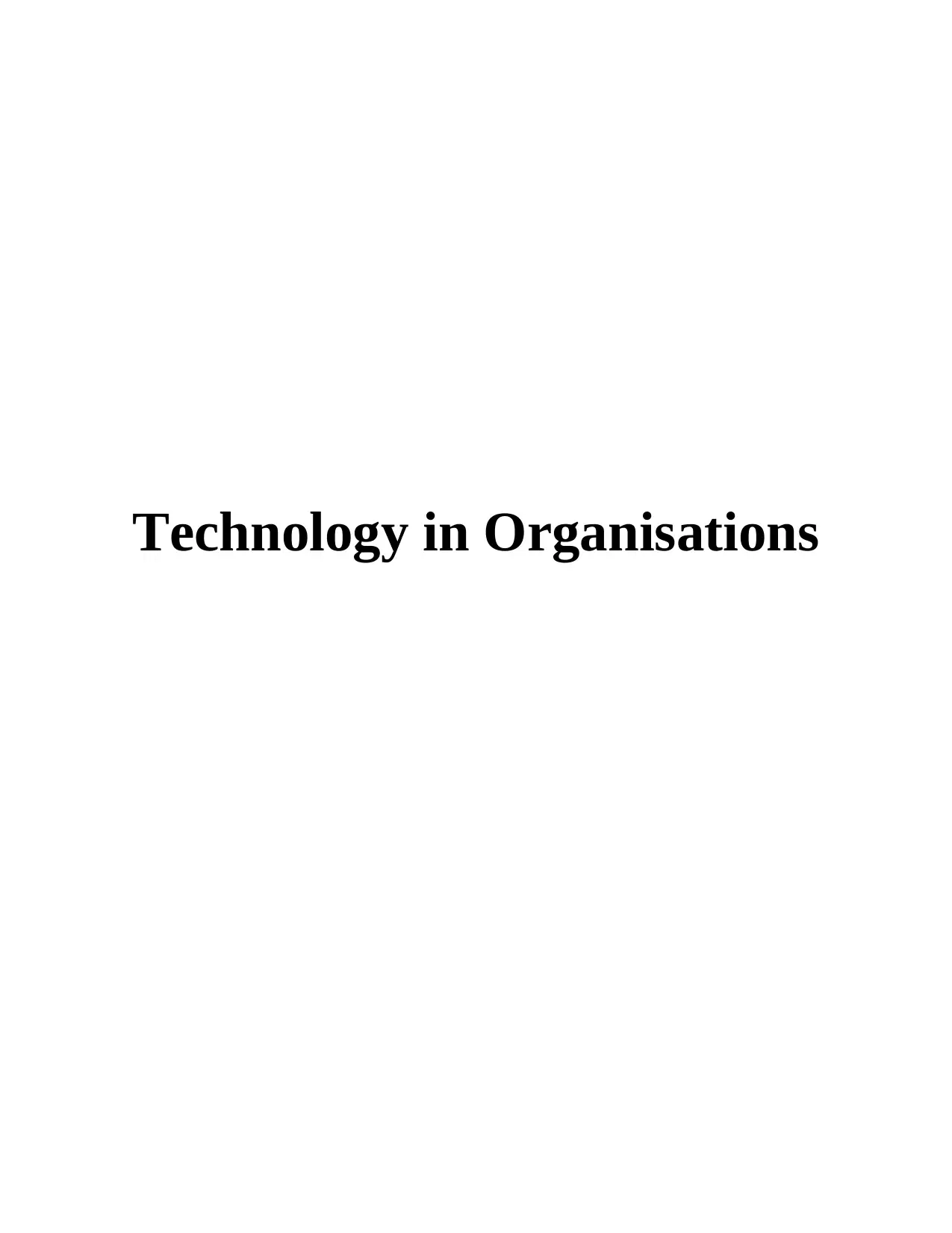
Technology in Organisations
Secure Best Marks with AI Grader
Need help grading? Try our AI Grader for instant feedback on your assignments.
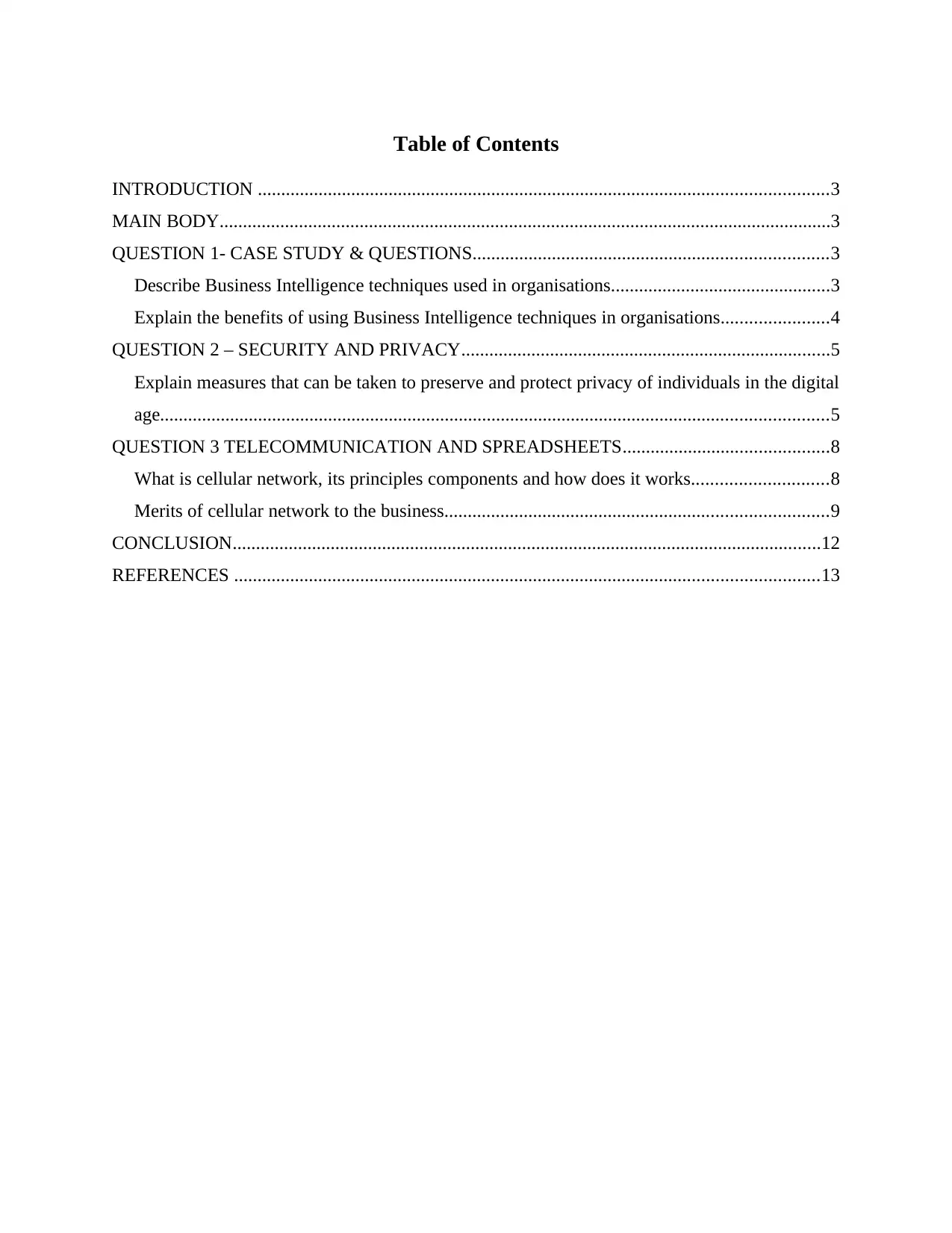
Table of Contents
INTRODUCTION ..........................................................................................................................3
MAIN BODY...................................................................................................................................3
QUESTION 1- CASE STUDY & QUESTIONS............................................................................3
Describe Business Intelligence techniques used in organisations...............................................3
Explain the benefits of using Business Intelligence techniques in organisations.......................4
QUESTION 2 – SECURITY AND PRIVACY...............................................................................5
Explain measures that can be taken to preserve and protect privacy of individuals in the digital
age...............................................................................................................................................5
QUESTION 3 TELECOMMUNICATION AND SPREADSHEETS............................................8
What is cellular network, its principles components and how does it works.............................8
Merits of cellular network to the business..................................................................................9
CONCLUSION..............................................................................................................................12
REFERENCES .............................................................................................................................13
INTRODUCTION ..........................................................................................................................3
MAIN BODY...................................................................................................................................3
QUESTION 1- CASE STUDY & QUESTIONS............................................................................3
Describe Business Intelligence techniques used in organisations...............................................3
Explain the benefits of using Business Intelligence techniques in organisations.......................4
QUESTION 2 – SECURITY AND PRIVACY...............................................................................5
Explain measures that can be taken to preserve and protect privacy of individuals in the digital
age...............................................................................................................................................5
QUESTION 3 TELECOMMUNICATION AND SPREADSHEETS............................................8
What is cellular network, its principles components and how does it works.............................8
Merits of cellular network to the business..................................................................................9
CONCLUSION..............................................................................................................................12
REFERENCES .............................................................................................................................13
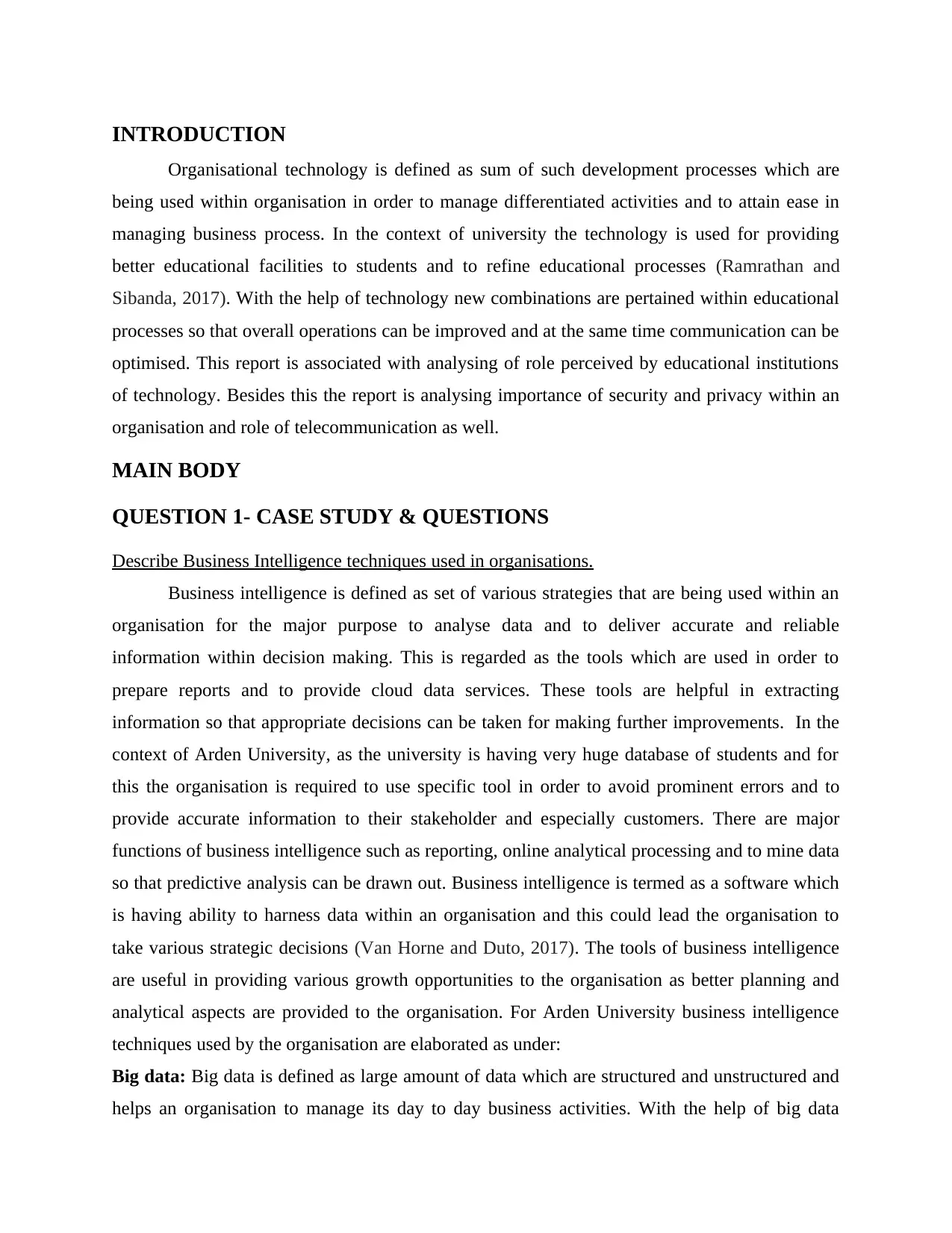
INTRODUCTION
Organisational technology is defined as sum of such development processes which are
being used within organisation in order to manage differentiated activities and to attain ease in
managing business process. In the context of university the technology is used for providing
better educational facilities to students and to refine educational processes (Ramrathan and
Sibanda, 2017). With the help of technology new combinations are pertained within educational
processes so that overall operations can be improved and at the same time communication can be
optimised. This report is associated with analysing of role perceived by educational institutions
of technology. Besides this the report is analysing importance of security and privacy within an
organisation and role of telecommunication as well.
MAIN BODY
QUESTION 1- CASE STUDY & QUESTIONS
Describe Business Intelligence techniques used in organisations.
Business intelligence is defined as set of various strategies that are being used within an
organisation for the major purpose to analyse data and to deliver accurate and reliable
information within decision making. This is regarded as the tools which are used in order to
prepare reports and to provide cloud data services. These tools are helpful in extracting
information so that appropriate decisions can be taken for making further improvements. In the
context of Arden University, as the university is having very huge database of students and for
this the organisation is required to use specific tool in order to avoid prominent errors and to
provide accurate information to their stakeholder and especially customers. There are major
functions of business intelligence such as reporting, online analytical processing and to mine data
so that predictive analysis can be drawn out. Business intelligence is termed as a software which
is having ability to harness data within an organisation and this could lead the organisation to
take various strategic decisions (Van Horne and Duto, 2017). The tools of business intelligence
are useful in providing various growth opportunities to the organisation as better planning and
analytical aspects are provided to the organisation. For Arden University business intelligence
techniques used by the organisation are elaborated as under:
Big data: Big data is defined as large amount of data which are structured and unstructured and
helps an organisation to manage its day to day business activities. With the help of big data
Organisational technology is defined as sum of such development processes which are
being used within organisation in order to manage differentiated activities and to attain ease in
managing business process. In the context of university the technology is used for providing
better educational facilities to students and to refine educational processes (Ramrathan and
Sibanda, 2017). With the help of technology new combinations are pertained within educational
processes so that overall operations can be improved and at the same time communication can be
optimised. This report is associated with analysing of role perceived by educational institutions
of technology. Besides this the report is analysing importance of security and privacy within an
organisation and role of telecommunication as well.
MAIN BODY
QUESTION 1- CASE STUDY & QUESTIONS
Describe Business Intelligence techniques used in organisations.
Business intelligence is defined as set of various strategies that are being used within an
organisation for the major purpose to analyse data and to deliver accurate and reliable
information within decision making. This is regarded as the tools which are used in order to
prepare reports and to provide cloud data services. These tools are helpful in extracting
information so that appropriate decisions can be taken for making further improvements. In the
context of Arden University, as the university is having very huge database of students and for
this the organisation is required to use specific tool in order to avoid prominent errors and to
provide accurate information to their stakeholder and especially customers. There are major
functions of business intelligence such as reporting, online analytical processing and to mine data
so that predictive analysis can be drawn out. Business intelligence is termed as a software which
is having ability to harness data within an organisation and this could lead the organisation to
take various strategic decisions (Van Horne and Duto, 2017). The tools of business intelligence
are useful in providing various growth opportunities to the organisation as better planning and
analytical aspects are provided to the organisation. For Arden University business intelligence
techniques used by the organisation are elaborated as under:
Big data: Big data is defined as large amount of data which are structured and unstructured and
helps an organisation to manage its day to day business activities. With the help of big data
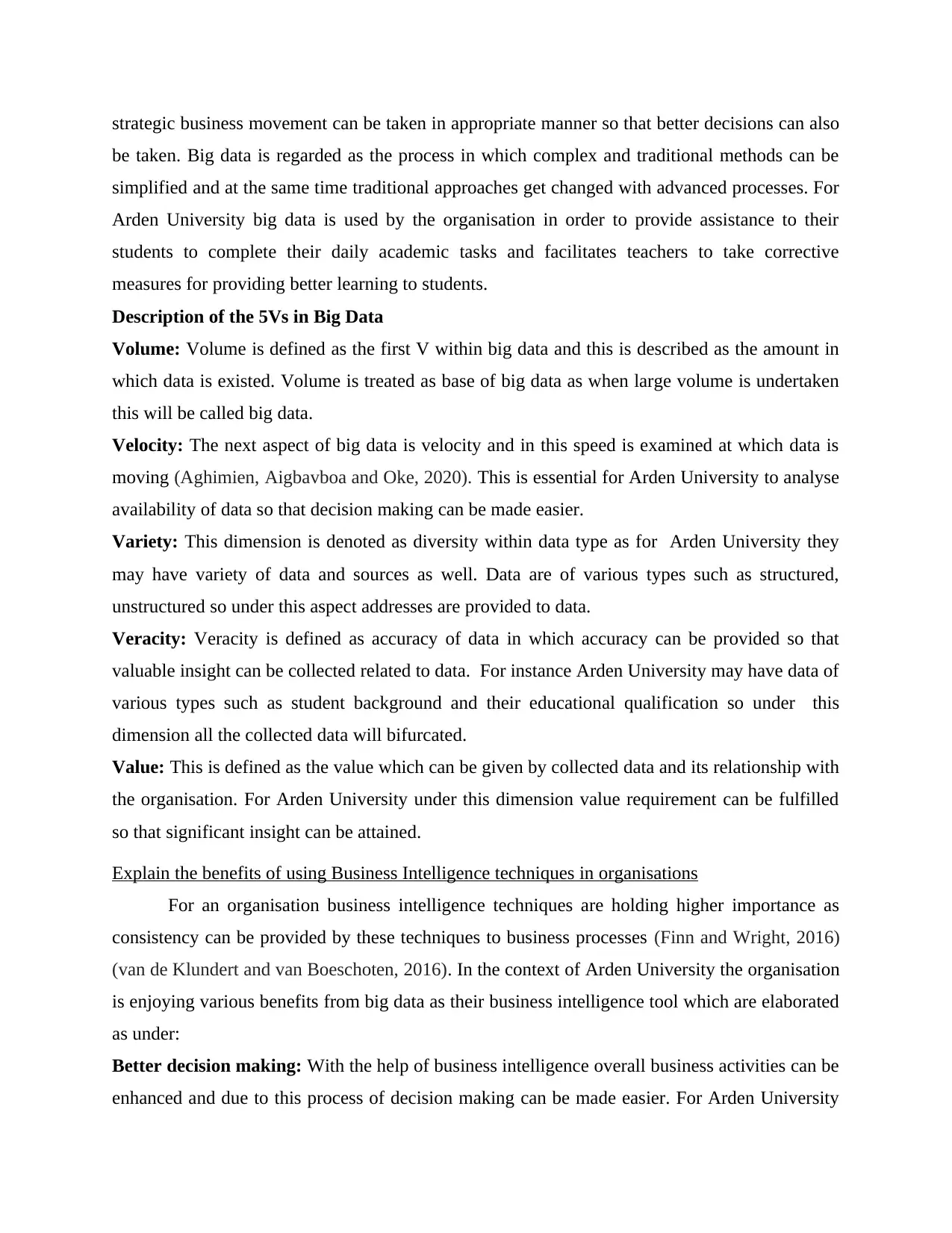
strategic business movement can be taken in appropriate manner so that better decisions can also
be taken. Big data is regarded as the process in which complex and traditional methods can be
simplified and at the same time traditional approaches get changed with advanced processes. For
Arden University big data is used by the organisation in order to provide assistance to their
students to complete their daily academic tasks and facilitates teachers to take corrective
measures for providing better learning to students.
Description of the 5Vs in Big Data
Volume: Volume is defined as the first V within big data and this is described as the amount in
which data is existed. Volume is treated as base of big data as when large volume is undertaken
this will be called big data.
Velocity: The next aspect of big data is velocity and in this speed is examined at which data is
moving (Aghimien, Aigbavboa and Oke, 2020). This is essential for Arden University to analyse
availability of data so that decision making can be made easier.
Variety: This dimension is denoted as diversity within data type as for Arden University they
may have variety of data and sources as well. Data are of various types such as structured,
unstructured so under this aspect addresses are provided to data.
Veracity: Veracity is defined as accuracy of data in which accuracy can be provided so that
valuable insight can be collected related to data. For instance Arden University may have data of
various types such as student background and their educational qualification so under this
dimension all the collected data will bifurcated.
Value: This is defined as the value which can be given by collected data and its relationship with
the organisation. For Arden University under this dimension value requirement can be fulfilled
so that significant insight can be attained.
Explain the benefits of using Business Intelligence techniques in organisations
For an organisation business intelligence techniques are holding higher importance as
consistency can be provided by these techniques to business processes (Finn and Wright, 2016)
(van de Klundert and van Boeschoten, 2016). In the context of Arden University the organisation
is enjoying various benefits from big data as their business intelligence tool which are elaborated
as under:
Better decision making: With the help of business intelligence overall business activities can be
enhanced and due to this process of decision making can be made easier. For Arden University
be taken. Big data is regarded as the process in which complex and traditional methods can be
simplified and at the same time traditional approaches get changed with advanced processes. For
Arden University big data is used by the organisation in order to provide assistance to their
students to complete their daily academic tasks and facilitates teachers to take corrective
measures for providing better learning to students.
Description of the 5Vs in Big Data
Volume: Volume is defined as the first V within big data and this is described as the amount in
which data is existed. Volume is treated as base of big data as when large volume is undertaken
this will be called big data.
Velocity: The next aspect of big data is velocity and in this speed is examined at which data is
moving (Aghimien, Aigbavboa and Oke, 2020). This is essential for Arden University to analyse
availability of data so that decision making can be made easier.
Variety: This dimension is denoted as diversity within data type as for Arden University they
may have variety of data and sources as well. Data are of various types such as structured,
unstructured so under this aspect addresses are provided to data.
Veracity: Veracity is defined as accuracy of data in which accuracy can be provided so that
valuable insight can be collected related to data. For instance Arden University may have data of
various types such as student background and their educational qualification so under this
dimension all the collected data will bifurcated.
Value: This is defined as the value which can be given by collected data and its relationship with
the organisation. For Arden University under this dimension value requirement can be fulfilled
so that significant insight can be attained.
Explain the benefits of using Business Intelligence techniques in organisations
For an organisation business intelligence techniques are holding higher importance as
consistency can be provided by these techniques to business processes (Finn and Wright, 2016)
(van de Klundert and van Boeschoten, 2016). In the context of Arden University the organisation
is enjoying various benefits from big data as their business intelligence tool which are elaborated
as under:
Better decision making: With the help of business intelligence overall business activities can be
enhanced and due to this process of decision making can be made easier. For Arden University
Secure Best Marks with AI Grader
Need help grading? Try our AI Grader for instant feedback on your assignments.
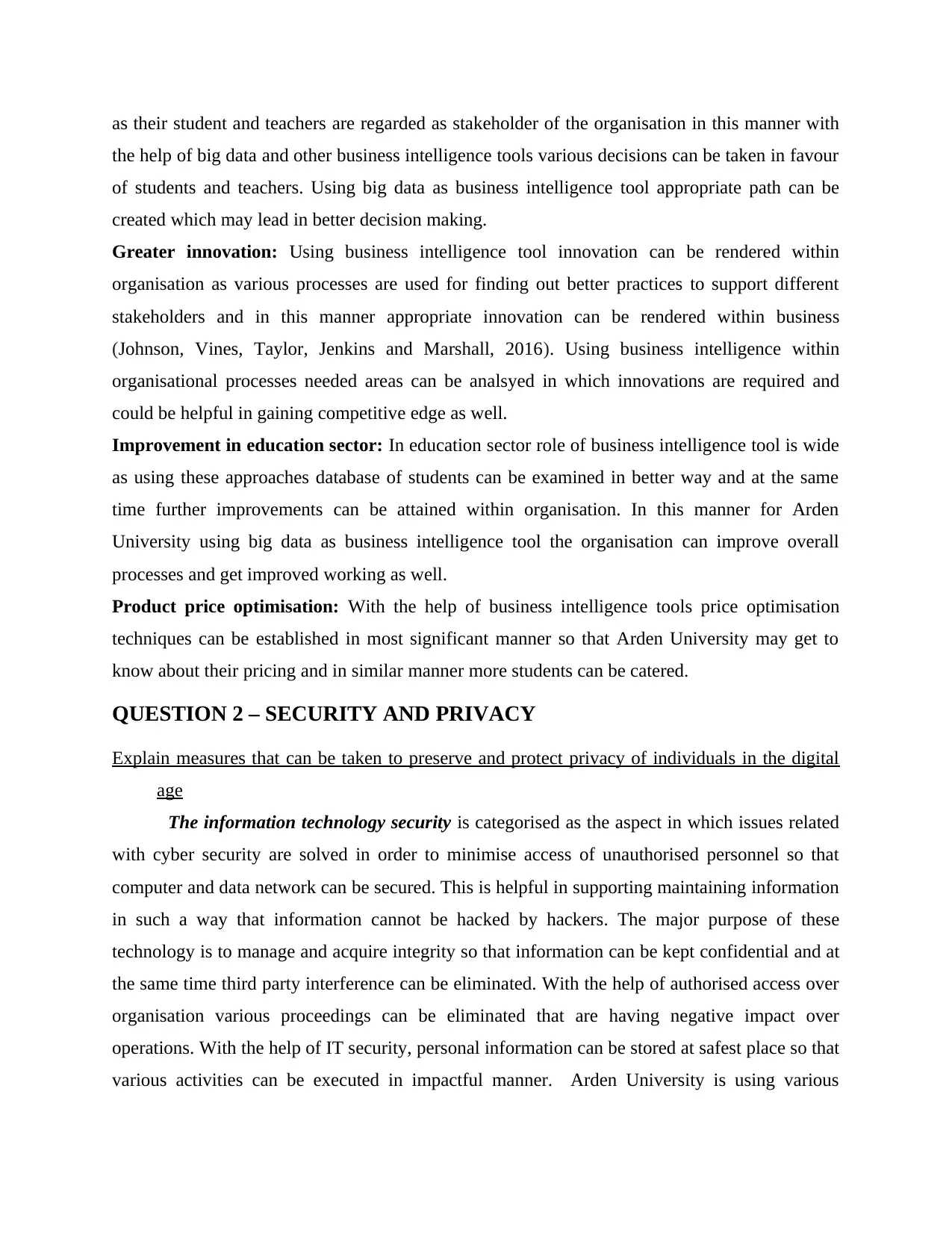
as their student and teachers are regarded as stakeholder of the organisation in this manner with
the help of big data and other business intelligence tools various decisions can be taken in favour
of students and teachers. Using big data as business intelligence tool appropriate path can be
created which may lead in better decision making.
Greater innovation: Using business intelligence tool innovation can be rendered within
organisation as various processes are used for finding out better practices to support different
stakeholders and in this manner appropriate innovation can be rendered within business
(Johnson, Vines, Taylor, Jenkins and Marshall, 2016). Using business intelligence within
organisational processes needed areas can be analsyed in which innovations are required and
could be helpful in gaining competitive edge as well.
Improvement in education sector: In education sector role of business intelligence tool is wide
as using these approaches database of students can be examined in better way and at the same
time further improvements can be attained within organisation. In this manner for Arden
University using big data as business intelligence tool the organisation can improve overall
processes and get improved working as well.
Product price optimisation: With the help of business intelligence tools price optimisation
techniques can be established in most significant manner so that Arden University may get to
know about their pricing and in similar manner more students can be catered.
QUESTION 2 – SECURITY AND PRIVACY
Explain measures that can be taken to preserve and protect privacy of individuals in the digital
age
The information technology security is categorised as the aspect in which issues related
with cyber security are solved in order to minimise access of unauthorised personnel so that
computer and data network can be secured. This is helpful in supporting maintaining information
in such a way that information cannot be hacked by hackers. The major purpose of these
technology is to manage and acquire integrity so that information can be kept confidential and at
the same time third party interference can be eliminated. With the help of authorised access over
organisation various proceedings can be eliminated that are having negative impact over
operations. With the help of IT security, personal information can be stored at safest place so that
various activities can be executed in impactful manner. Arden University is using various
the help of big data and other business intelligence tools various decisions can be taken in favour
of students and teachers. Using big data as business intelligence tool appropriate path can be
created which may lead in better decision making.
Greater innovation: Using business intelligence tool innovation can be rendered within
organisation as various processes are used for finding out better practices to support different
stakeholders and in this manner appropriate innovation can be rendered within business
(Johnson, Vines, Taylor, Jenkins and Marshall, 2016). Using business intelligence within
organisational processes needed areas can be analsyed in which innovations are required and
could be helpful in gaining competitive edge as well.
Improvement in education sector: In education sector role of business intelligence tool is wide
as using these approaches database of students can be examined in better way and at the same
time further improvements can be attained within organisation. In this manner for Arden
University using big data as business intelligence tool the organisation can improve overall
processes and get improved working as well.
Product price optimisation: With the help of business intelligence tools price optimisation
techniques can be established in most significant manner so that Arden University may get to
know about their pricing and in similar manner more students can be catered.
QUESTION 2 – SECURITY AND PRIVACY
Explain measures that can be taken to preserve and protect privacy of individuals in the digital
age
The information technology security is categorised as the aspect in which issues related
with cyber security are solved in order to minimise access of unauthorised personnel so that
computer and data network can be secured. This is helpful in supporting maintaining information
in such a way that information cannot be hacked by hackers. The major purpose of these
technology is to manage and acquire integrity so that information can be kept confidential and at
the same time third party interference can be eliminated. With the help of authorised access over
organisation various proceedings can be eliminated that are having negative impact over
operations. With the help of IT security, personal information can be stored at safest place so that
various activities can be executed in impactful manner. Arden University is using various
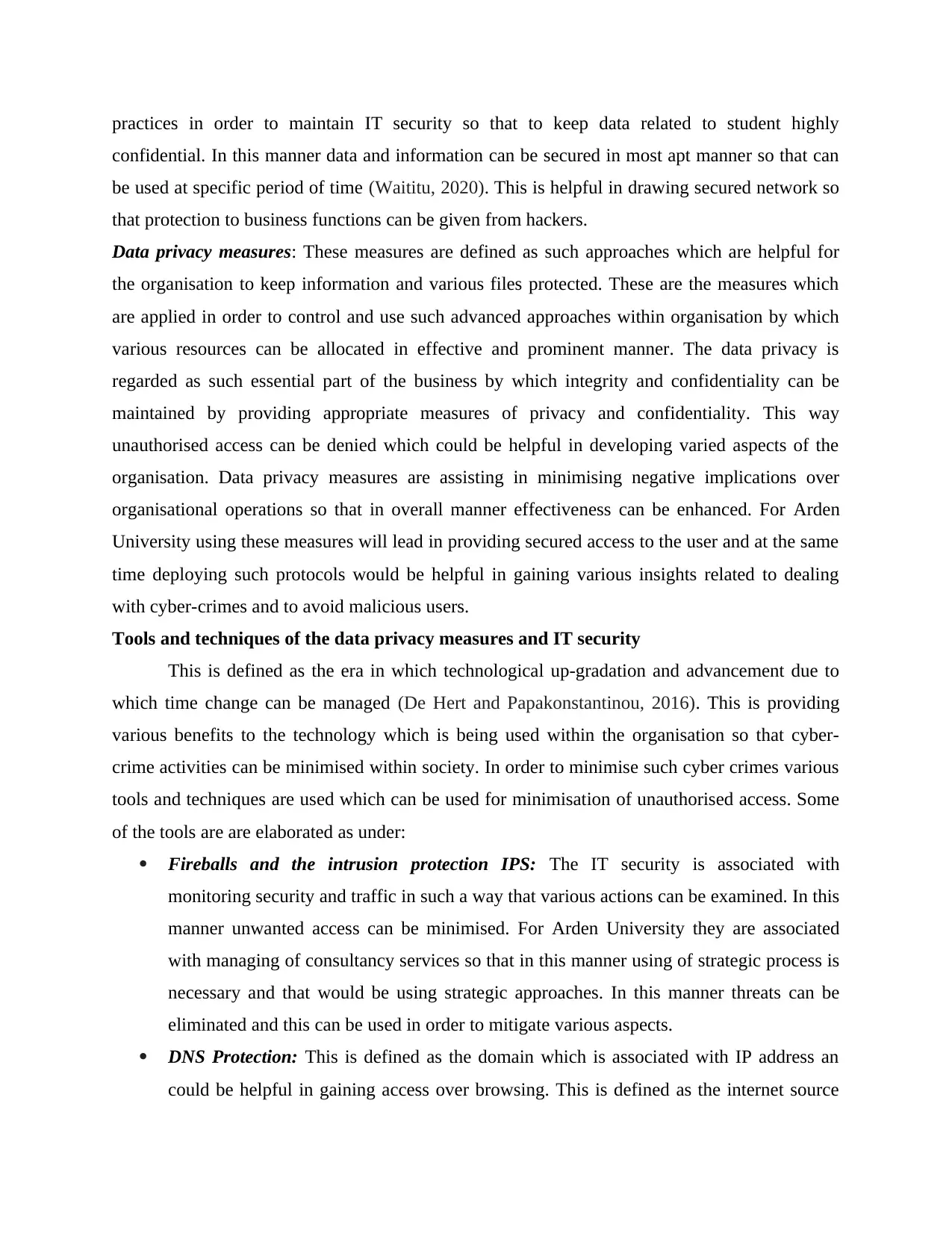
practices in order to maintain IT security so that to keep data related to student highly
confidential. In this manner data and information can be secured in most apt manner so that can
be used at specific period of time (Waititu, 2020). This is helpful in drawing secured network so
that protection to business functions can be given from hackers.
Data privacy measures: These measures are defined as such approaches which are helpful for
the organisation to keep information and various files protected. These are the measures which
are applied in order to control and use such advanced approaches within organisation by which
various resources can be allocated in effective and prominent manner. The data privacy is
regarded as such essential part of the business by which integrity and confidentiality can be
maintained by providing appropriate measures of privacy and confidentiality. This way
unauthorised access can be denied which could be helpful in developing varied aspects of the
organisation. Data privacy measures are assisting in minimising negative implications over
organisational operations so that in overall manner effectiveness can be enhanced. For Arden
University using these measures will lead in providing secured access to the user and at the same
time deploying such protocols would be helpful in gaining various insights related to dealing
with cyber-crimes and to avoid malicious users.
Tools and techniques of the data privacy measures and IT security
This is defined as the era in which technological up-gradation and advancement due to
which time change can be managed (De Hert and Papakonstantinou, 2016). This is providing
various benefits to the technology which is being used within the organisation so that cyber-
crime activities can be minimised within society. In order to minimise such cyber crimes various
tools and techniques are used which can be used for minimisation of unauthorised access. Some
of the tools are are elaborated as under:
Fireballs and the intrusion protection IPS: The IT security is associated with
monitoring security and traffic in such a way that various actions can be examined. In this
manner unwanted access can be minimised. For Arden University they are associated
with managing of consultancy services so that in this manner using of strategic process is
necessary and that would be using strategic approaches. In this manner threats can be
eliminated and this can be used in order to mitigate various aspects.
DNS Protection: This is defined as the domain which is associated with IP address an
could be helpful in gaining access over browsing. This is defined as the internet source
confidential. In this manner data and information can be secured in most apt manner so that can
be used at specific period of time (Waititu, 2020). This is helpful in drawing secured network so
that protection to business functions can be given from hackers.
Data privacy measures: These measures are defined as such approaches which are helpful for
the organisation to keep information and various files protected. These are the measures which
are applied in order to control and use such advanced approaches within organisation by which
various resources can be allocated in effective and prominent manner. The data privacy is
regarded as such essential part of the business by which integrity and confidentiality can be
maintained by providing appropriate measures of privacy and confidentiality. This way
unauthorised access can be denied which could be helpful in developing varied aspects of the
organisation. Data privacy measures are assisting in minimising negative implications over
organisational operations so that in overall manner effectiveness can be enhanced. For Arden
University using these measures will lead in providing secured access to the user and at the same
time deploying such protocols would be helpful in gaining various insights related to dealing
with cyber-crimes and to avoid malicious users.
Tools and techniques of the data privacy measures and IT security
This is defined as the era in which technological up-gradation and advancement due to
which time change can be managed (De Hert and Papakonstantinou, 2016). This is providing
various benefits to the technology which is being used within the organisation so that cyber-
crime activities can be minimised within society. In order to minimise such cyber crimes various
tools and techniques are used which can be used for minimisation of unauthorised access. Some
of the tools are are elaborated as under:
Fireballs and the intrusion protection IPS: The IT security is associated with
monitoring security and traffic in such a way that various actions can be examined. In this
manner unwanted access can be minimised. For Arden University they are associated
with managing of consultancy services so that in this manner using of strategic process is
necessary and that would be using strategic approaches. In this manner threats can be
eliminated and this can be used in order to mitigate various aspects.
DNS Protection: This is defined as the domain which is associated with IP address an
could be helpful in gaining access over browsing. This is defined as the internet source
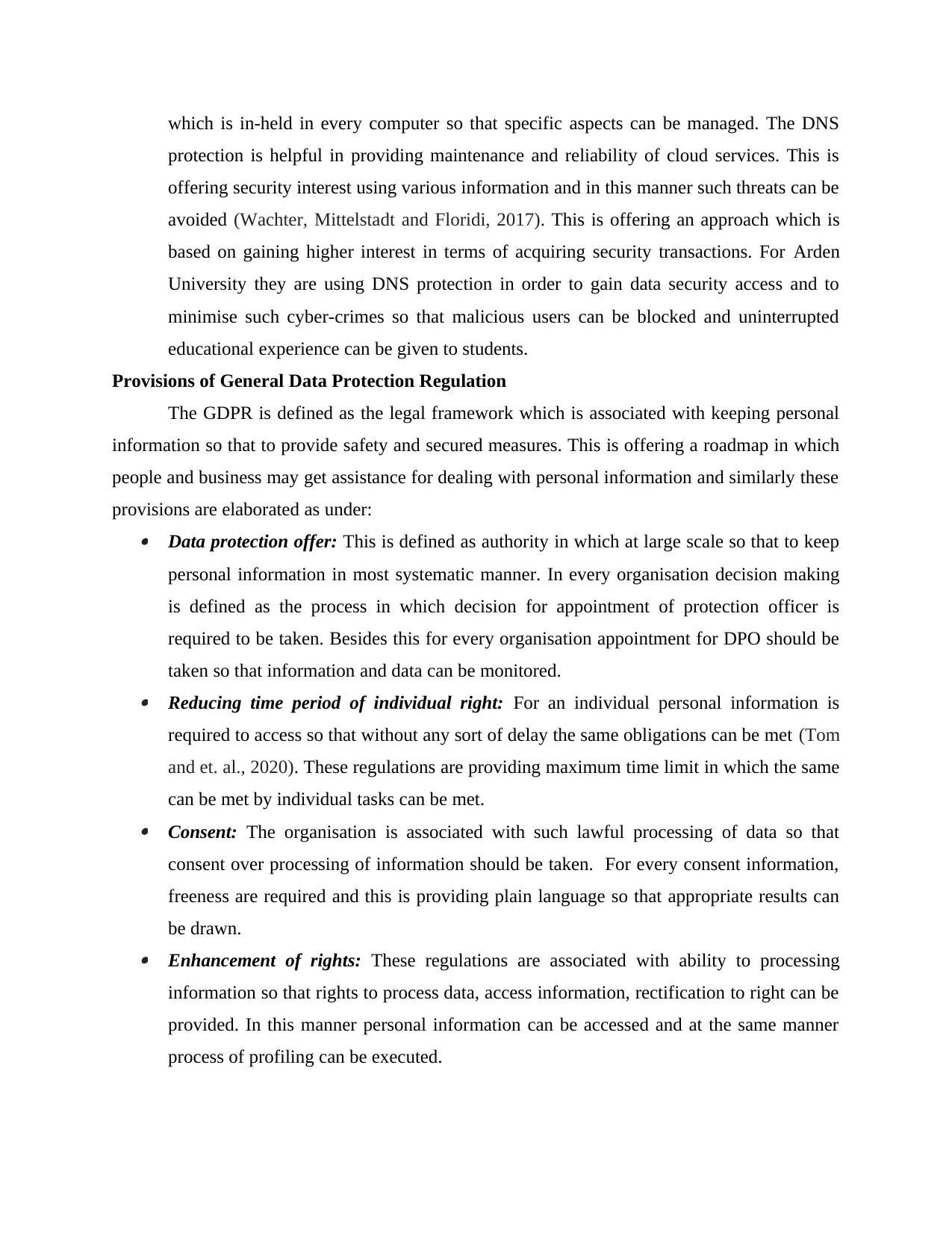
which is in-held in every computer so that specific aspects can be managed. The DNS
protection is helpful in providing maintenance and reliability of cloud services. This is
offering security interest using various information and in this manner such threats can be
avoided (Wachter, Mittelstadt and Floridi, 2017). This is offering an approach which is
based on gaining higher interest in terms of acquiring security transactions. For Arden
University they are using DNS protection in order to gain data security access and to
minimise such cyber-crimes so that malicious users can be blocked and uninterrupted
educational experience can be given to students.
Provisions of General Data Protection Regulation
The GDPR is defined as the legal framework which is associated with keeping personal
information so that to provide safety and secured measures. This is offering a roadmap in which
people and business may get assistance for dealing with personal information and similarly these
provisions are elaborated as under: Data protection offer: This is defined as authority in which at large scale so that to keep
personal information in most systematic manner. In every organisation decision making
is defined as the process in which decision for appointment of protection officer is
required to be taken. Besides this for every organisation appointment for DPO should be
taken so that information and data can be monitored. Reducing time period of individual right: For an individual personal information is
required to access so that without any sort of delay the same obligations can be met (Tom
and et. al., 2020). These regulations are providing maximum time limit in which the same
can be met by individual tasks can be met. Consent: The organisation is associated with such lawful processing of data so that
consent over processing of information should be taken. For every consent information,
freeness are required and this is providing plain language so that appropriate results can
be drawn. Enhancement of rights: These regulations are associated with ability to processing
information so that rights to process data, access information, rectification to right can be
provided. In this manner personal information can be accessed and at the same manner
process of profiling can be executed.
protection is helpful in providing maintenance and reliability of cloud services. This is
offering security interest using various information and in this manner such threats can be
avoided (Wachter, Mittelstadt and Floridi, 2017). This is offering an approach which is
based on gaining higher interest in terms of acquiring security transactions. For Arden
University they are using DNS protection in order to gain data security access and to
minimise such cyber-crimes so that malicious users can be blocked and uninterrupted
educational experience can be given to students.
Provisions of General Data Protection Regulation
The GDPR is defined as the legal framework which is associated with keeping personal
information so that to provide safety and secured measures. This is offering a roadmap in which
people and business may get assistance for dealing with personal information and similarly these
provisions are elaborated as under: Data protection offer: This is defined as authority in which at large scale so that to keep
personal information in most systematic manner. In every organisation decision making
is defined as the process in which decision for appointment of protection officer is
required to be taken. Besides this for every organisation appointment for DPO should be
taken so that information and data can be monitored. Reducing time period of individual right: For an individual personal information is
required to access so that without any sort of delay the same obligations can be met (Tom
and et. al., 2020). These regulations are providing maximum time limit in which the same
can be met by individual tasks can be met. Consent: The organisation is associated with such lawful processing of data so that
consent over processing of information should be taken. For every consent information,
freeness are required and this is providing plain language so that appropriate results can
be drawn. Enhancement of rights: These regulations are associated with ability to processing
information so that rights to process data, access information, rectification to right can be
provided. In this manner personal information can be accessed and at the same manner
process of profiling can be executed.
Paraphrase This Document
Need a fresh take? Get an instant paraphrase of this document with our AI Paraphraser
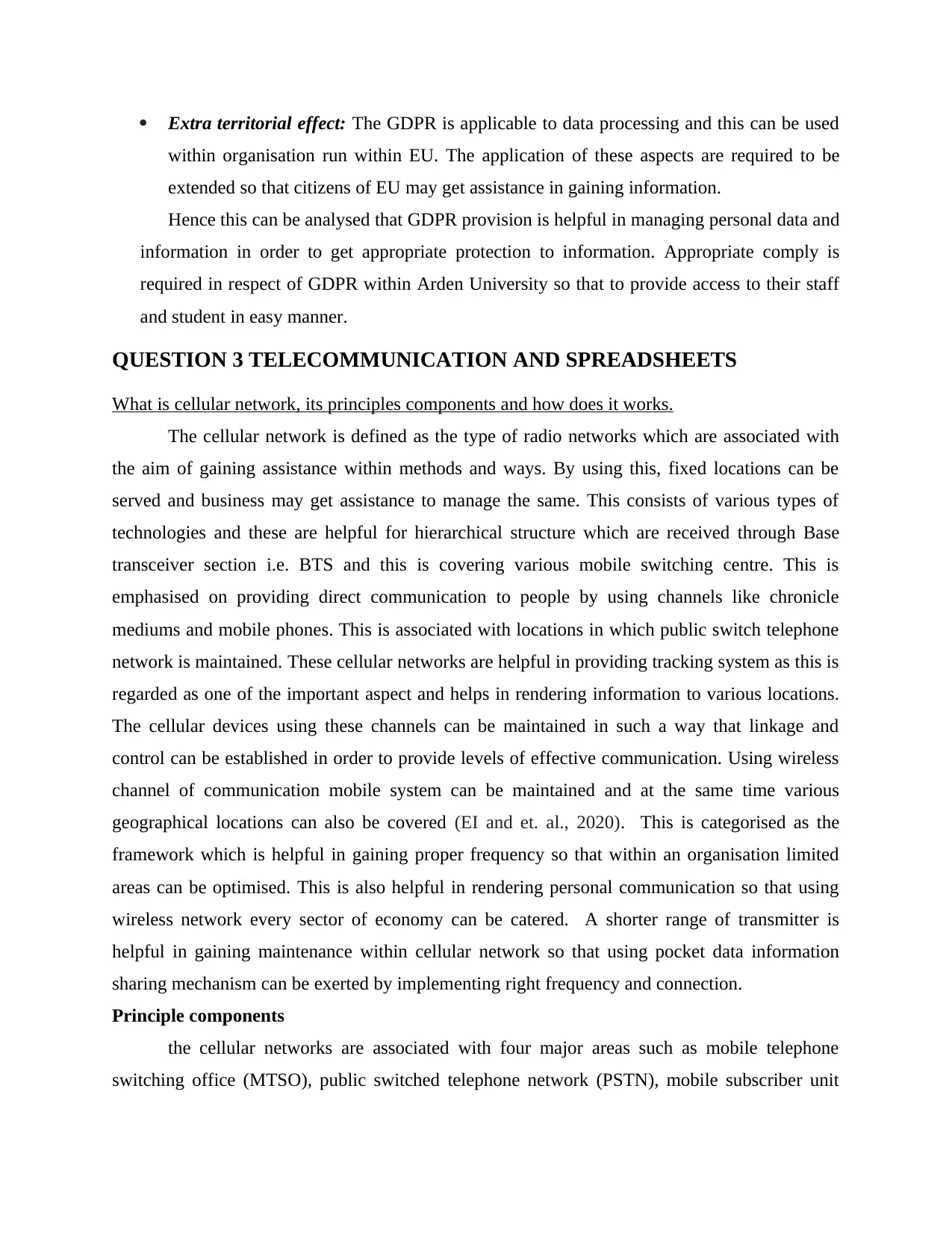
Extra territorial effect: The GDPR is applicable to data processing and this can be used
within organisation run within EU. The application of these aspects are required to be
extended so that citizens of EU may get assistance in gaining information.
Hence this can be analysed that GDPR provision is helpful in managing personal data and
information in order to get appropriate protection to information. Appropriate comply is
required in respect of GDPR within Arden University so that to provide access to their staff
and student in easy manner.
QUESTION 3 TELECOMMUNICATION AND SPREADSHEETS
What is cellular network, its principles components and how does it works.
The cellular network is defined as the type of radio networks which are associated with
the aim of gaining assistance within methods and ways. By using this, fixed locations can be
served and business may get assistance to manage the same. This consists of various types of
technologies and these are helpful for hierarchical structure which are received through Base
transceiver section i.e. BTS and this is covering various mobile switching centre. This is
emphasised on providing direct communication to people by using channels like chronicle
mediums and mobile phones. This is associated with locations in which public switch telephone
network is maintained. These cellular networks are helpful in providing tracking system as this is
regarded as one of the important aspect and helps in rendering information to various locations.
The cellular devices using these channels can be maintained in such a way that linkage and
control can be established in order to provide levels of effective communication. Using wireless
channel of communication mobile system can be maintained and at the same time various
geographical locations can also be covered (EI and et. al., 2020). This is categorised as the
framework which is helpful in gaining proper frequency so that within an organisation limited
areas can be optimised. This is also helpful in rendering personal communication so that using
wireless network every sector of economy can be catered. A shorter range of transmitter is
helpful in gaining maintenance within cellular network so that using pocket data information
sharing mechanism can be exerted by implementing right frequency and connection.
Principle components
the cellular networks are associated with four major areas such as mobile telephone
switching office (MTSO), public switched telephone network (PSTN), mobile subscriber unit
within organisation run within EU. The application of these aspects are required to be
extended so that citizens of EU may get assistance in gaining information.
Hence this can be analysed that GDPR provision is helpful in managing personal data and
information in order to get appropriate protection to information. Appropriate comply is
required in respect of GDPR within Arden University so that to provide access to their staff
and student in easy manner.
QUESTION 3 TELECOMMUNICATION AND SPREADSHEETS
What is cellular network, its principles components and how does it works.
The cellular network is defined as the type of radio networks which are associated with
the aim of gaining assistance within methods and ways. By using this, fixed locations can be
served and business may get assistance to manage the same. This consists of various types of
technologies and these are helpful for hierarchical structure which are received through Base
transceiver section i.e. BTS and this is covering various mobile switching centre. This is
emphasised on providing direct communication to people by using channels like chronicle
mediums and mobile phones. This is associated with locations in which public switch telephone
network is maintained. These cellular networks are helpful in providing tracking system as this is
regarded as one of the important aspect and helps in rendering information to various locations.
The cellular devices using these channels can be maintained in such a way that linkage and
control can be established in order to provide levels of effective communication. Using wireless
channel of communication mobile system can be maintained and at the same time various
geographical locations can also be covered (EI and et. al., 2020). This is categorised as the
framework which is helpful in gaining proper frequency so that within an organisation limited
areas can be optimised. This is also helpful in rendering personal communication so that using
wireless network every sector of economy can be catered. A shorter range of transmitter is
helpful in gaining maintenance within cellular network so that using pocket data information
sharing mechanism can be exerted by implementing right frequency and connection.
Principle components
the cellular networks are associated with four major areas such as mobile telephone
switching office (MTSO), public switched telephone network (PSTN), mobile subscriber unit
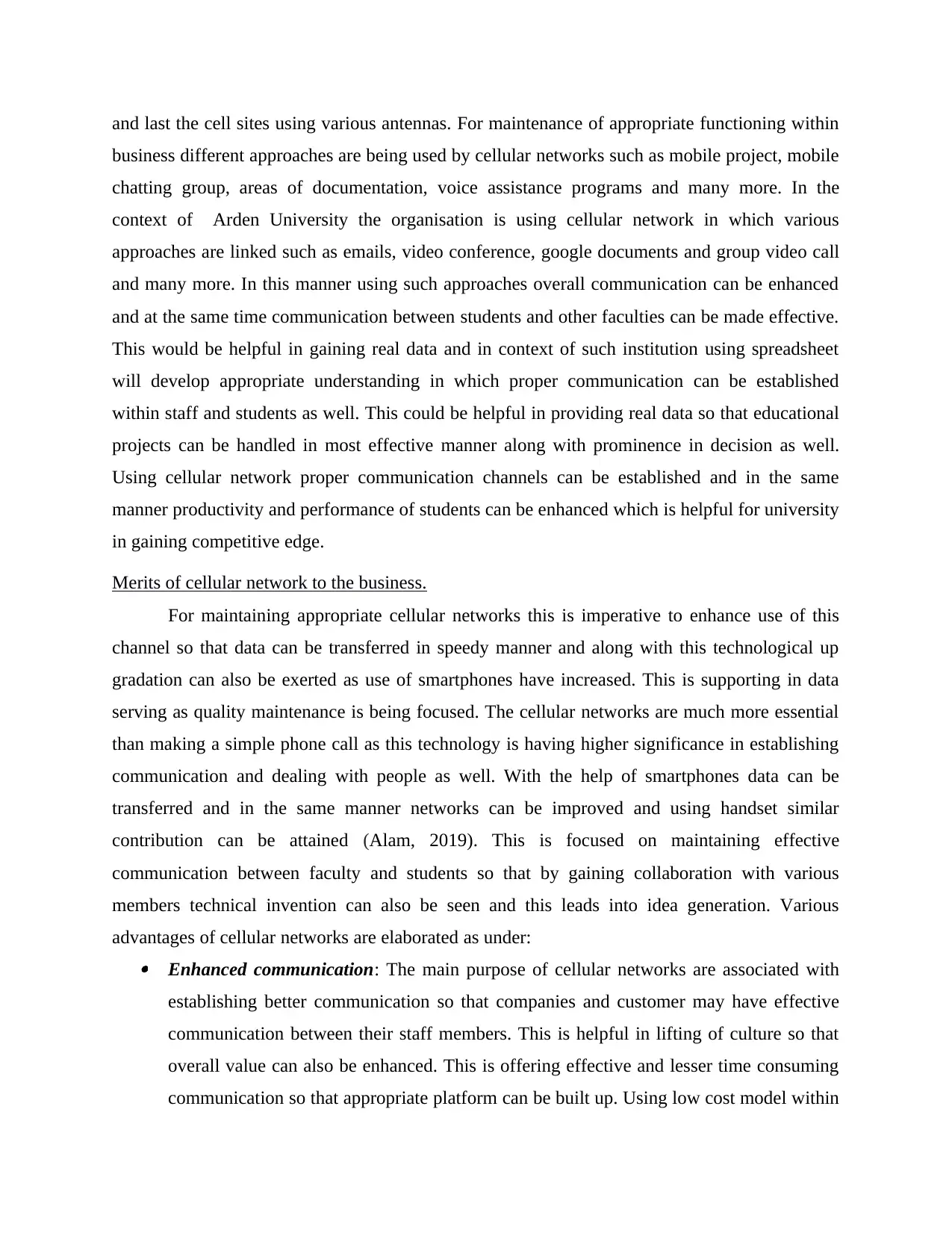
and last the cell sites using various antennas. For maintenance of appropriate functioning within
business different approaches are being used by cellular networks such as mobile project, mobile
chatting group, areas of documentation, voice assistance programs and many more. In the
context of Arden University the organisation is using cellular network in which various
approaches are linked such as emails, video conference, google documents and group video call
and many more. In this manner using such approaches overall communication can be enhanced
and at the same time communication between students and other faculties can be made effective.
This would be helpful in gaining real data and in context of such institution using spreadsheet
will develop appropriate understanding in which proper communication can be established
within staff and students as well. This could be helpful in providing real data so that educational
projects can be handled in most effective manner along with prominence in decision as well.
Using cellular network proper communication channels can be established and in the same
manner productivity and performance of students can be enhanced which is helpful for university
in gaining competitive edge.
Merits of cellular network to the business.
For maintaining appropriate cellular networks this is imperative to enhance use of this
channel so that data can be transferred in speedy manner and along with this technological up
gradation can also be exerted as use of smartphones have increased. This is supporting in data
serving as quality maintenance is being focused. The cellular networks are much more essential
than making a simple phone call as this technology is having higher significance in establishing
communication and dealing with people as well. With the help of smartphones data can be
transferred and in the same manner networks can be improved and using handset similar
contribution can be attained (Alam, 2019). This is focused on maintaining effective
communication between faculty and students so that by gaining collaboration with various
members technical invention can also be seen and this leads into idea generation. Various
advantages of cellular networks are elaborated as under: Enhanced communication: The main purpose of cellular networks are associated with
establishing better communication so that companies and customer may have effective
communication between their staff members. This is helpful in lifting of culture so that
overall value can also be enhanced. This is offering effective and lesser time consuming
communication so that appropriate platform can be built up. Using low cost model within
business different approaches are being used by cellular networks such as mobile project, mobile
chatting group, areas of documentation, voice assistance programs and many more. In the
context of Arden University the organisation is using cellular network in which various
approaches are linked such as emails, video conference, google documents and group video call
and many more. In this manner using such approaches overall communication can be enhanced
and at the same time communication between students and other faculties can be made effective.
This would be helpful in gaining real data and in context of such institution using spreadsheet
will develop appropriate understanding in which proper communication can be established
within staff and students as well. This could be helpful in providing real data so that educational
projects can be handled in most effective manner along with prominence in decision as well.
Using cellular network proper communication channels can be established and in the same
manner productivity and performance of students can be enhanced which is helpful for university
in gaining competitive edge.
Merits of cellular network to the business.
For maintaining appropriate cellular networks this is imperative to enhance use of this
channel so that data can be transferred in speedy manner and along with this technological up
gradation can also be exerted as use of smartphones have increased. This is supporting in data
serving as quality maintenance is being focused. The cellular networks are much more essential
than making a simple phone call as this technology is having higher significance in establishing
communication and dealing with people as well. With the help of smartphones data can be
transferred and in the same manner networks can be improved and using handset similar
contribution can be attained (Alam, 2019). This is focused on maintaining effective
communication between faculty and students so that by gaining collaboration with various
members technical invention can also be seen and this leads into idea generation. Various
advantages of cellular networks are elaborated as under: Enhanced communication: The main purpose of cellular networks are associated with
establishing better communication so that companies and customer may have effective
communication between their staff members. This is helpful in lifting of culture so that
overall value can also be enhanced. This is offering effective and lesser time consuming
communication so that appropriate platform can be built up. Using low cost model within
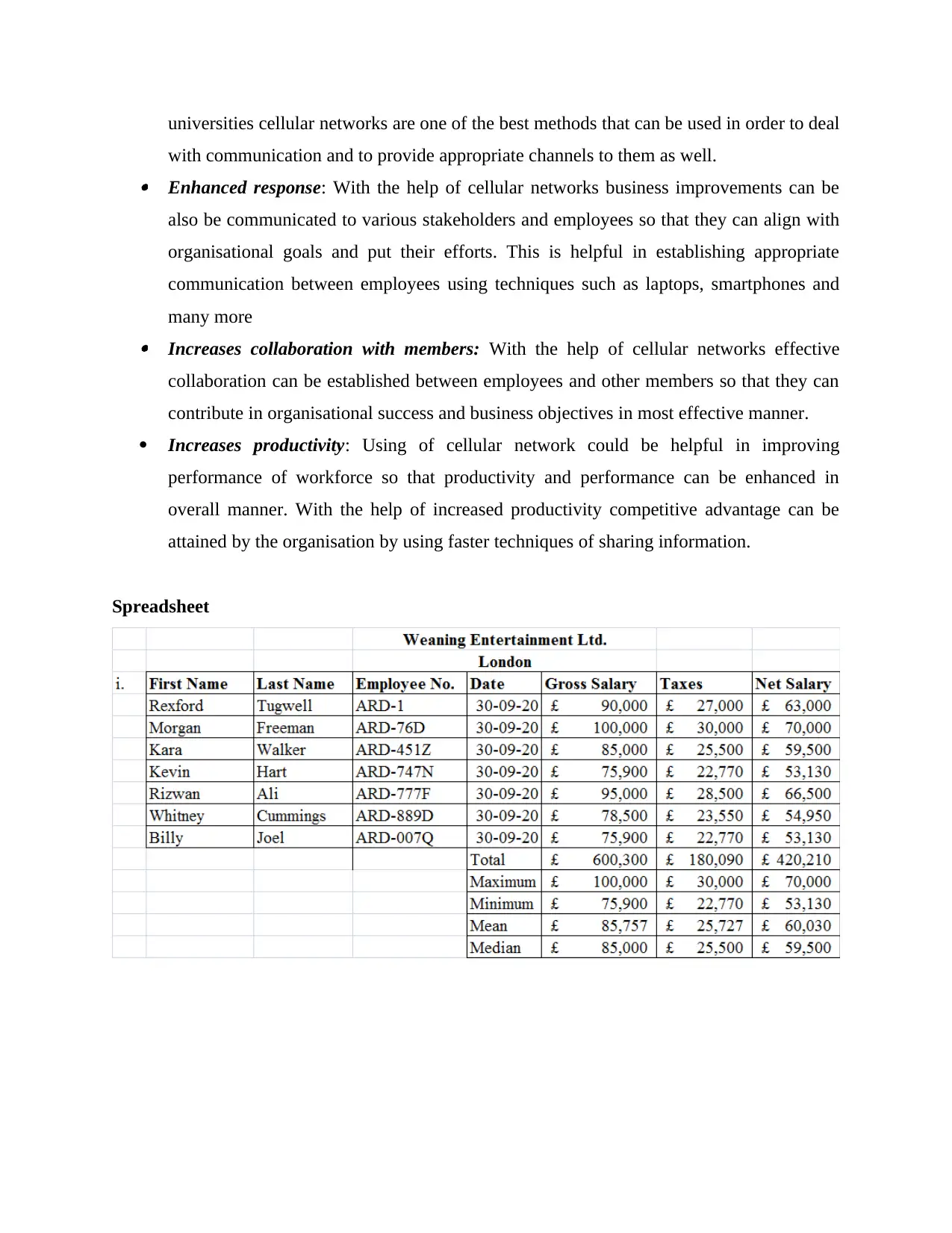
universities cellular networks are one of the best methods that can be used in order to deal
with communication and to provide appropriate channels to them as well. Enhanced response: With the help of cellular networks business improvements can be
also be communicated to various stakeholders and employees so that they can align with
organisational goals and put their efforts. This is helpful in establishing appropriate
communication between employees using techniques such as laptops, smartphones and
many more Increases collaboration with members: With the help of cellular networks effective
collaboration can be established between employees and other members so that they can
contribute in organisational success and business objectives in most effective manner.
Increases productivity: Using of cellular network could be helpful in improving
performance of workforce so that productivity and performance can be enhanced in
overall manner. With the help of increased productivity competitive advantage can be
attained by the organisation by using faster techniques of sharing information.
Spreadsheet
with communication and to provide appropriate channels to them as well. Enhanced response: With the help of cellular networks business improvements can be
also be communicated to various stakeholders and employees so that they can align with
organisational goals and put their efforts. This is helpful in establishing appropriate
communication between employees using techniques such as laptops, smartphones and
many more Increases collaboration with members: With the help of cellular networks effective
collaboration can be established between employees and other members so that they can
contribute in organisational success and business objectives in most effective manner.
Increases productivity: Using of cellular network could be helpful in improving
performance of workforce so that productivity and performance can be enhanced in
overall manner. With the help of increased productivity competitive advantage can be
attained by the organisation by using faster techniques of sharing information.
Spreadsheet
Secure Best Marks with AI Grader
Need help grading? Try our AI Grader for instant feedback on your assignments.

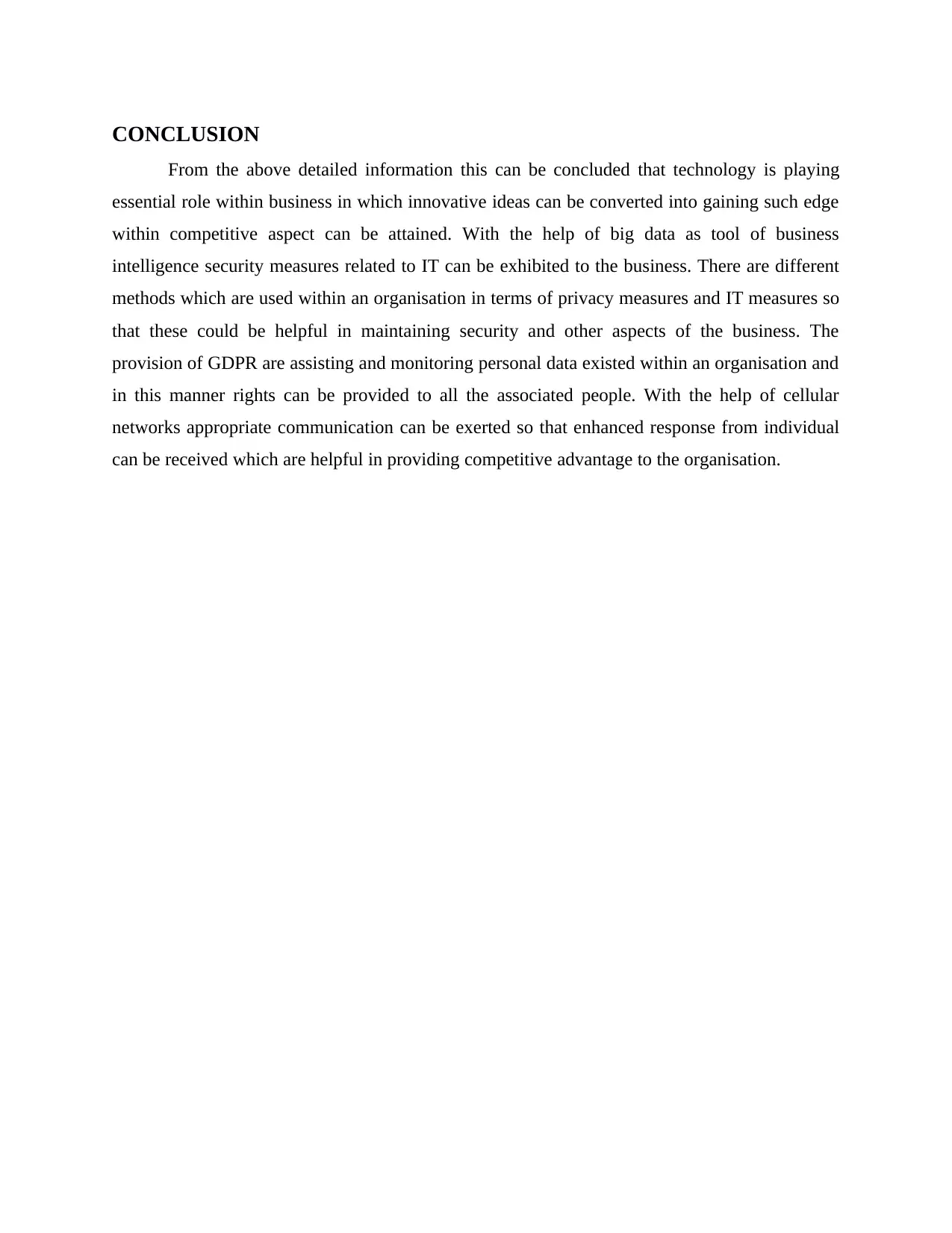
CONCLUSION
From the above detailed information this can be concluded that technology is playing
essential role within business in which innovative ideas can be converted into gaining such edge
within competitive aspect can be attained. With the help of big data as tool of business
intelligence security measures related to IT can be exhibited to the business. There are different
methods which are used within an organisation in terms of privacy measures and IT measures so
that these could be helpful in maintaining security and other aspects of the business. The
provision of GDPR are assisting and monitoring personal data existed within an organisation and
in this manner rights can be provided to all the associated people. With the help of cellular
networks appropriate communication can be exerted so that enhanced response from individual
can be received which are helpful in providing competitive advantage to the organisation.
From the above detailed information this can be concluded that technology is playing
essential role within business in which innovative ideas can be converted into gaining such edge
within competitive aspect can be attained. With the help of big data as tool of business
intelligence security measures related to IT can be exhibited to the business. There are different
methods which are used within an organisation in terms of privacy measures and IT measures so
that these could be helpful in maintaining security and other aspects of the business. The
provision of GDPR are assisting and monitoring personal data existed within an organisation and
in this manner rights can be provided to all the associated people. With the help of cellular
networks appropriate communication can be exerted so that enhanced response from individual
can be received which are helpful in providing competitive advantage to the organisation.
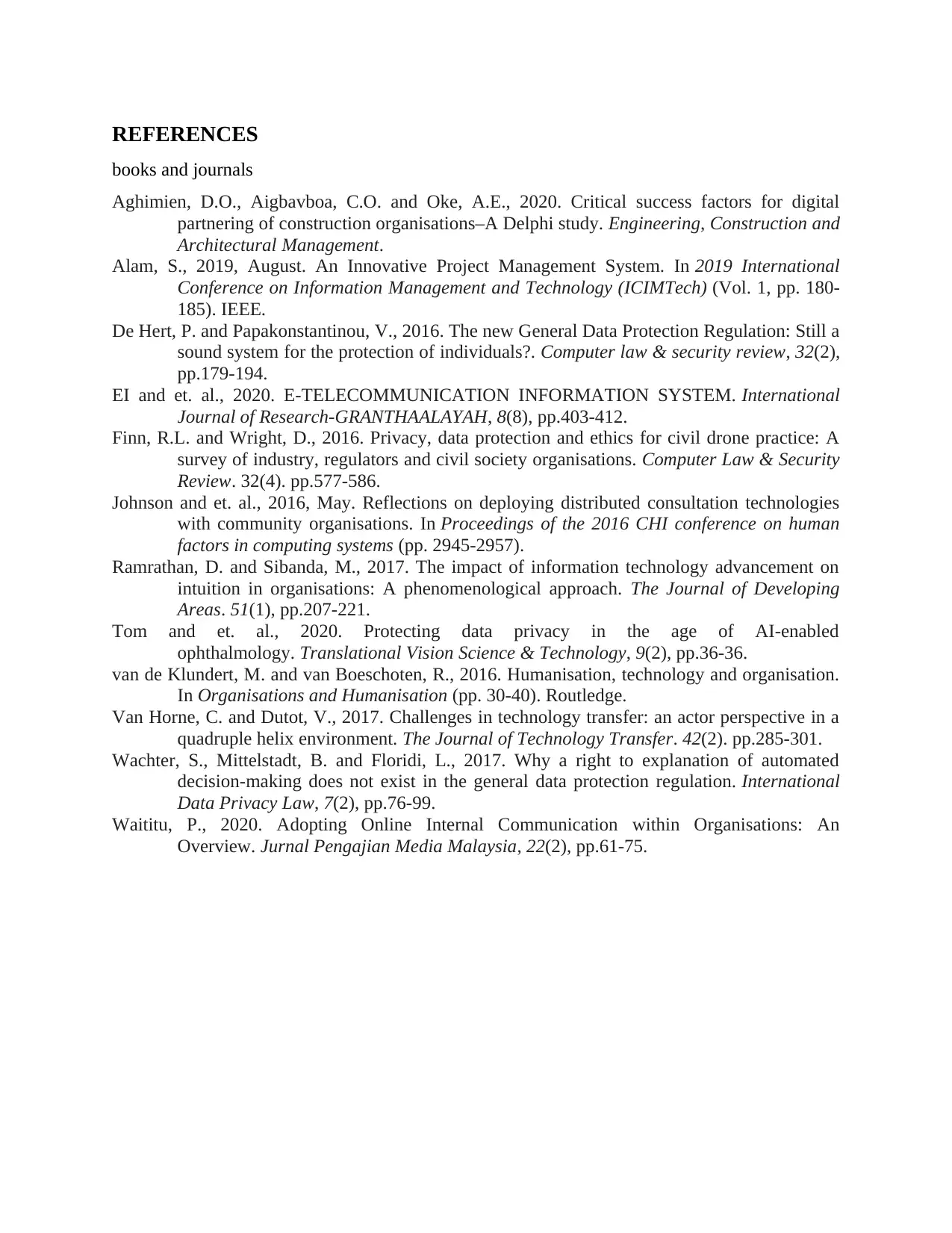
REFERENCES
books and journals
Aghimien, D.O., Aigbavboa, C.O. and Oke, A.E., 2020. Critical success factors for digital
partnering of construction organisations–A Delphi study. Engineering, Construction and
Architectural Management.
Alam, S., 2019, August. An Innovative Project Management System. In 2019 International
Conference on Information Management and Technology (ICIMTech) (Vol. 1, pp. 180-
185). IEEE.
De Hert, P. and Papakonstantinou, V., 2016. The new General Data Protection Regulation: Still a
sound system for the protection of individuals?. Computer law & security review, 32(2),
pp.179-194.
EI and et. al., 2020. E-TELECOMMUNICATION INFORMATION SYSTEM. International
Journal of Research-GRANTHAALAYAH, 8(8), pp.403-412.
Finn, R.L. and Wright, D., 2016. Privacy, data protection and ethics for civil drone practice: A
survey of industry, regulators and civil society organisations. Computer Law & Security
Review. 32(4). pp.577-586.
Johnson and et. al., 2016, May. Reflections on deploying distributed consultation technologies
with community organisations. In Proceedings of the 2016 CHI conference on human
factors in computing systems (pp. 2945-2957).
Ramrathan, D. and Sibanda, M., 2017. The impact of information technology advancement on
intuition in organisations: A phenomenological approach. The Journal of Developing
Areas. 51(1), pp.207-221.
Tom and et. al., 2020. Protecting data privacy in the age of AI-enabled
ophthalmology. Translational Vision Science & Technology, 9(2), pp.36-36.
van de Klundert, M. and van Boeschoten, R., 2016. Humanisation, technology and organisation.
In Organisations and Humanisation (pp. 30-40). Routledge.
Van Horne, C. and Dutot, V., 2017. Challenges in technology transfer: an actor perspective in a
quadruple helix environment. The Journal of Technology Transfer. 42(2). pp.285-301.
Wachter, S., Mittelstadt, B. and Floridi, L., 2017. Why a right to explanation of automated
decision-making does not exist in the general data protection regulation. International
Data Privacy Law, 7(2), pp.76-99.
Waititu, P., 2020. Adopting Online Internal Communication within Organisations: An
Overview. Jurnal Pengajian Media Malaysia, 22(2), pp.61-75.
books and journals
Aghimien, D.O., Aigbavboa, C.O. and Oke, A.E., 2020. Critical success factors for digital
partnering of construction organisations–A Delphi study. Engineering, Construction and
Architectural Management.
Alam, S., 2019, August. An Innovative Project Management System. In 2019 International
Conference on Information Management and Technology (ICIMTech) (Vol. 1, pp. 180-
185). IEEE.
De Hert, P. and Papakonstantinou, V., 2016. The new General Data Protection Regulation: Still a
sound system for the protection of individuals?. Computer law & security review, 32(2),
pp.179-194.
EI and et. al., 2020. E-TELECOMMUNICATION INFORMATION SYSTEM. International
Journal of Research-GRANTHAALAYAH, 8(8), pp.403-412.
Finn, R.L. and Wright, D., 2016. Privacy, data protection and ethics for civil drone practice: A
survey of industry, regulators and civil society organisations. Computer Law & Security
Review. 32(4). pp.577-586.
Johnson and et. al., 2016, May. Reflections on deploying distributed consultation technologies
with community organisations. In Proceedings of the 2016 CHI conference on human
factors in computing systems (pp. 2945-2957).
Ramrathan, D. and Sibanda, M., 2017. The impact of information technology advancement on
intuition in organisations: A phenomenological approach. The Journal of Developing
Areas. 51(1), pp.207-221.
Tom and et. al., 2020. Protecting data privacy in the age of AI-enabled
ophthalmology. Translational Vision Science & Technology, 9(2), pp.36-36.
van de Klundert, M. and van Boeschoten, R., 2016. Humanisation, technology and organisation.
In Organisations and Humanisation (pp. 30-40). Routledge.
Van Horne, C. and Dutot, V., 2017. Challenges in technology transfer: an actor perspective in a
quadruple helix environment. The Journal of Technology Transfer. 42(2). pp.285-301.
Wachter, S., Mittelstadt, B. and Floridi, L., 2017. Why a right to explanation of automated
decision-making does not exist in the general data protection regulation. International
Data Privacy Law, 7(2), pp.76-99.
Waititu, P., 2020. Adopting Online Internal Communication within Organisations: An
Overview. Jurnal Pengajian Media Malaysia, 22(2), pp.61-75.
1 out of 13
Related Documents
Your All-in-One AI-Powered Toolkit for Academic Success.
+13062052269
info@desklib.com
Available 24*7 on WhatsApp / Email
![[object Object]](/_next/static/media/star-bottom.7253800d.svg)
Unlock your academic potential
© 2024 | Zucol Services PVT LTD | All rights reserved.





